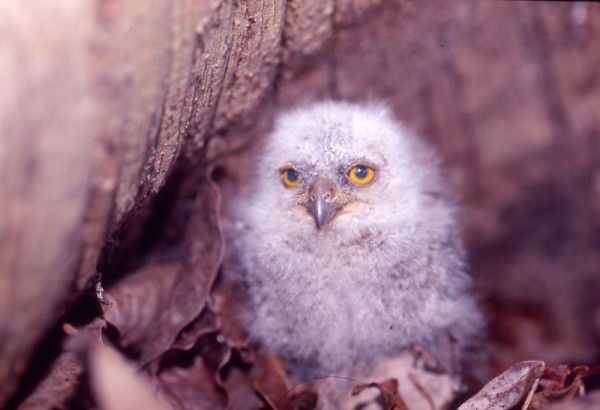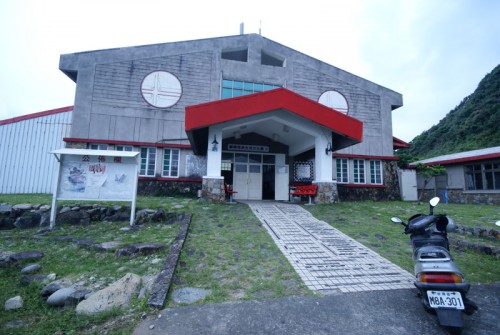TELDAP Collections
| You Can Find Your Footprint in My Song |
|
Syaman Rapongan listens attentively to a familiar voice pouring from the speakers — a piece of memory that his father has left behind. The melodious singing unfolds like the steady ocean tide, enchanting listeners with its clarity. Each wave seems to reflect the lives of Lanyu islanders, and the foam brought in by the tide remains on the shore like the memories of days gone by. The song is carried away by the ocean breeze, leaving behind lingering regrets and remembrance. In April 2008, the Tao’s Aboriginal Songs and Culture Digital Archive Project invited Lanyu writer Syaman Rapongan to be their keynote speaker at a workshop entitled “Socio-cultural Meaning of Tao Songs from an Anthropological Perspective.” At the workshop, Syaman Rapongan played a recording of his father’s singing in remembrance of the man who had died in 2003 and in honor of the tradition of passing down knowledge and memories through song. As his book Memory of the Ocean Waves indicates: “The ocean is like one cold-blooded shadow after another, drowning traces of emotional warmth. It is also one restless tide after another, forever adding new waves of longing in the mind.”
Unfortunately, a landslide induced by heavy rain destroyed most of the cassettes stored in the house. Syaman Rapongan was left with only one recording of an ancient song sung by his father. He often listens to the same song played over and over to remember his father. After the digital archive program started to unfold in 2005 on Lanyu Island, program director professor Kuo Liang-wen and his team found seven additional hymns sung by his father on tapes collected by early researchers of history and culture. The “Beauty of Aboriginal Music: Tao (Yami) and Rukai Traditional Songs Digital Archive Project” also provided him with three more songs. Upon receiving these audio recordings of a familiar voice, memories tore through the writer’s mind, and his families traditions were properly restored.
For Not Letting It Go With the Wind
Perhaps because of this heart-warming connection, professors Kuo Liang-wen and Lin Su-gan have devoted considerable efforts to maintaining this piece of oral history, as well as conserving the culture of Lanyu Island. “We use digital methods to bestow new life upon these relics, allowing more access. For this reason, I think our project is very meaningful,” said professor Lin Su-gan.
Many surveys and research projects, both official and academic, have been conducted on Lanyu, with various groups poring over data and records, and doing field studies on myths, legends, and rituals. The research has focused on analyzing family structure, society’s organization, Lanyu’s economy, and the customs of the Tao people. These research projects have helped unveil the mystery of Lanyu. For example, in an article entitled “Orchid Island Series: Lonely Reef,” written by Kuan Hsiao-jung and published in “Human” magazine vol. 36 in April 1987, the author notes that, “The lives of Yami elders are still deeply rooted in the land and oceans of Lanyu.” This article reports on the conflict and struggles of the local people from the perspectives of the working class, and is accompanied by stunning black-and-white photos, painting an impressive picture of Lanyu. These kinds of articles and reports have allowed outsiders to get a glimpse into the local life and true colors of Lanyu, and understand how the Tao people position themselves amongst high mountains and vast seas.
In 1977, a young Christian missionary named Lin Mao-an came to Lanyu alone, saying he was accompanied only by God. He lived among the Yami people and felt strongly that the continued impact of interaction with other civilizations was shaping Lanyu into a land of culture clashes between the traditional and the modern. Through education, medical care, religion, communication, and social services, Lin and the Lanyu people confronted modernization head on, and in 1979 founded the “Lan En Cultural and Educational Foundation.” Besides assisting the local residents with cultural conflicts, Lin also showed solidarity with the people of Lanyu by reporting on and recording Lanyu culture through media outlets such as the “Lanyu Bi-weekly Magazine” and the Lanyu Broadcasting Station. These media outlets reported on the local people and their affairs from a grassroots perspective, recording a remarkable amount of information about local life. Professor Kuo Liang-wen discovered this information accidentally, and ever since the ship of the digital archive project has continued to sail towards the shores of Lanyu Island.
Youth Activity Center of Lan En Cultural and Educational Foundation
Over the past 30 years, the Lan En Cultural and Educational Foundation has accumulated sources that are intimately relevant to the lives of local residents. News of a new building project or the location of a ship’s arrival all reveal important information about the lives of Lanyu’s residents. Professor Kuo has converted all of the data into word documents, facilitating access to the database and further enhancing the circulation of Lanyu news. Meanwhile, the “Orchid Island Aboriginal Media Database” has categorized all sorts of news events into feature articles, examining and reviewing social events from the perspective of Lanyu locals. Tao beliefs, traditional customs, legends, and other information are published as feature articles on the webpage. Every word is as fresh as the ocean breeze, showcasing the local cultural landscape in the socio-cultural context of Lanyu.
Surging Tides of Memory
The “Orchid Island Aboriginal Media Database” has provided a good platform and communication channel for the digital archive project; it became the prototype of the project’s vision. In the second year of “Tao’s Aboriginal Songs and Culture Digital Archive Project,” an important premise was to clarify the goals of the project before contacting potential sponsors and participants. The existing database has been set up so that everyone can be assured of ownership of copy rights. The database is a reference platform, and preserves the project’s original goal of conserving, promoting, and educating people about Lanyu’s culture. Future development and use of these resources will unfold with respect to the resource owners. As the Lanyu people gradually became familiar with professor Kuo’s digital archive project team, they were more willing to provide cultural resources that they wanted to preserve to the team for digital conversion.
As more resources were collected, the types of information became more varied. In order to organize the database results, the project team set up the “Digital Archive Website of Orchid Island’s Media and Culture.” Under the topic of “Lanyu,” many special cultural segments have been set up, such as the wall painting of Red Head Catholic Church, anecdotes about pastor Tung and his jokes, and 360 degrees panoramic photos of local landscape. The webpage is constructed with a more flexible design concept that transcends the conventions of traditional databases, reflecting local perspectives.
“We conduct field research for the digital archive project. Many digital archive projects do not require the project team to build long-term, close relationships with their local partners in order to gain their trust before acquiring primary materials. Unlike many other museums, which may already have a rich data collection, we must demonstrate continued effort in order for our local partners to believe we are sincere in helping them, in mutual development, rather than for our own selfish ends. When they trust our team and see the results of our work, they will recognize the assistance that the project has offered to Lanyu,” said professor Kuo Liang-wen. Therefore, while working on the project, Kuo always offered unconditional help to the local residents, including helping the Lan En Foundation with upkeep on their audio-visual records for folk-song competitions and helping the households convert outdated slides and VHS tapes into digital videos. These acts not only won the trust of the local residents, but helped start friendships.
Insights from Digitalization
 A fledgling scops owl photographed by Pastor Tung Sen-yung
The “Orchid Island Aboriginal Media Database” has become a window through which people can learn about Lanyu’s customs, culture, and local affairs. The database also offers tremendous assistance to teachers and researchers. For example, pastor Tung Sen-yung accumulated all kinds of photographs from Lanyu, but lacked ecological photos, which can be found in the database, for him to use in speeches and lectures to introduce the ecology of Lanyu. The abundance of resources found in the database can help fill the gaps of private collections.
“The database contains all issues of the ‘Lanyu Bi-weekly Magazine’ from the past 20 years. Users can search keywords such as ‘flying fish season’ in the index, and all related articles will be displayed,” said professor Kuo. Sometimes, a project team member will exclaim to one of the researchers, “You have written many articles!” Often, researchers have forgotten the extent of the articles they have written, and are surprised to learn of the articles that are archived and published on the site, as is the case with Hsieh Yung-Chuan’s radio program “In Between Black Tides,” which has a total of more than 60 episodes. Every episode includes a traditional story about Lanyu. The digital archive project has completed all of the transcripts for the audio files. The transcripts may be edited and compiled into a book in the future, to promote the culture and legends of Lanyu.
As if Canoeing in the Ocean
Into the sea, towards the boundless future
Five years into the project, there have been voices of support as well as criticism. Many people have questioned whether this database can really be of service to the Tao people. Critics have wondered, “If we use the keyword ‘Li-bang-bang’ (flying fish in the Tao language) to search the database, can we still find the data we want?” Professor Kuo has responded by saying that though the database cannot currently search Romanized native words, this kind of feedback is essential for improving the database. “When we enter data, we will now begin to apply an authorized control method to important nouns in order to incorporate Tao Romanization and Chinese characters. The same results will appear by searching using either Tao or Chinese keywords.” When professor Kuo talks about how the project might be expanded, his eyes sparkle with excitement, as if he cannot wait to develop better and more advanced technologies to promote the continuation of these memories.
Digital technology not only conserves the images, sounds, and memories of Lanyu, but also allows warriors of the next generation to find new motivation from the memories of the past, in the songs of the ocean. In Memory of the Ocean Waves, Syaman Rapongan writes, “Mother moved back to her original tribe, and Father lost a partner to speak to ever since (“speaking” can also mean a heart beating). It was not only the changing tides that held memories in them, as every night my father sang to soothe his frustration (occasionally he confuses dusk and dawn). I was my father’s only loyal audience in dark corners…” He feels the emotion behind the ancient songs. As long as the island does not sink, life will continue to ebb and flow with the tides. The songs will still be sung, and Lanyu’s stories and memories will be never-ending.
References:
Liu Chi-wei, Culture and Art of the Formosan Aborigines. Taipei: Hsiung-Shih Art Book, 1995.
Hsu Yin-chou, Beauty of Lanyu. Taipei: Council for Cultural Affairs, 1984.
Syaman Rapongan, Memory of the Ocean Waves. Taipei: UNITAS Publishing Co.
|














